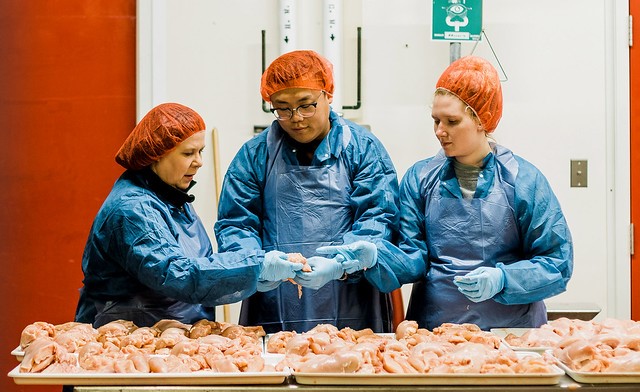Accelerometers may help detect poultry meat defects
Researchers plan to use accelerometers to identify meat quality problems, as defects may vibrate differently from undamaged meat.
June 5, 2020

Can a Fitbit help deliver a better chicken dinner? University of Arkansas researchers Casey Owens, Qinghua Li and Yan Huang are proposing the use of accelerometer technology to do just that.
Poultry science professor Owens and assistant professor of animal science Yan Huang, both in the University of Arkansas System Division of Agriculture, along with Li, associate professor in the University of Arkansas department of computer science and computer engineering, have been awarded a research grant from the U.S. Poultry & Egg Assn. for research to detect woody breast in broilers using accelerometer technology.
For Fitbits and lots of other devices that monitor or measure motion, accelerometers are what make them work. Owens said woody breast is one of numerous potential meat quality defects and is perhaps the one most responsible for dissatisfied chicken consumers.
Owens, the Novus International professor of poultry science at the Arkansas Agricultural Experiment Station, conducts research on meat quality defects in broiler meat, including woody breast, white striping and others. She recently developed predictive models for the detection of woody breast in broiler carcasses using image analysis of shapes associated with woody breast, a process for which she is seeking a patent, the university said in an announcement.
Li conducts research in mobile sensing, artificial intelligence and cybersecurity. He has used various sensors on mobile platforms to develop anomaly detection and machine learning technologies to address challenges in multiple disciplines.
“The broiler industry has been challenged with a condition referred to as woody breast for the past several years that can affect a significant proportion of products,” Owens said. “It is a condition that develops early in life and becomes more pronounced as birds get closer to market age. It results in compositional changes within the meat, namely an increase in collagen and fat, which further impact meat quality.”
Owens said woody breast has lower water holding capacity and decreased binding ability that affects some processed products. It also causes alterations to cooked meat, making it rubbery, tough or crunchy.
“The result can be substantial economic losses for the poultry industry,” Owens said. “It can cost the industry millions of dollars annually due to lost yield, increased processing costs for more labor to sort product and lost business because of customer dissatisfaction.” The ability to detect woody breast could help avoid those costs, Owens said.
She teamed up with Li and Huang to apply technology from the world of fitness and health monitoring to the poultry industry.
Good vibrations
Accelerometers are common technology today, Li said. Designed to measure changes in inertia, they are used in Fitbits and other wrist devices to count steps, in smartphones to detect motion and in cars for many purposes, including activating the airbag in an accident. Accelerometers can even measure vibrations, and that is how Li wants to employ them.
“Woody breast must vibrate and transfer vibration differently from normal breast,” Li said. “Modern accelerometers have high resolution, as shown in various health applications, and should be able to capture such differences when combined with machine learning.”
In research expected to begin this fall, Li plans to attach accelerometers to the breasts of live birds in hopes of identifying motions associated with woody breast.
Li will also place the devices on top of deboned breast meat. Vibrations will be introduced through a countertop and measured as they move through the meat, he said. These will be correlated with woody breast defects that may be present.
“Preliminary data suggest that muscles can present varying vibration patterns via accelerometers depending on degrees of woody breast severity,” Li said. “It is likely that muscle with increased collagen — indicating woody breast — and normal muscle have rather different mechanical properties that would lead to differences in vibration patterns.”
Owens said, “Development of tools that the industry can use has been an interest for us. We will have the ability to use this technology and combine it with other measurements that we have assessed for woody breast predictors, such as bird and carcass dimensions and fillet hardness.
“This proposed research is novel, unique and has the potential to provide a useful tool to the poultry industry for detection of woody breast in live broilers and fillets,” Owens said.
Early intervention
Owens said there is a great deal of ongoing research to determine the root causes of this condition in broilers.
Woody breast is more commonly found in older, larger broilers, Owens said, so it can affect those markets that favor larger birds, especially larger chicken breasts.
“Developing a more predictive method of identifying birds in the field would allow better selection of animals for research and breeding programs,” she said.
Owens added that online process control is a developing area for the poultry industry because it allows processors to have more real-time quality control. The use of online assessment tools to predict woody breast would be useful to processors for the ability to sort fillets and then segregate and divert woody breast away from premium whole-muscle products into more suitable products like patties and nuggets.
You May Also Like



